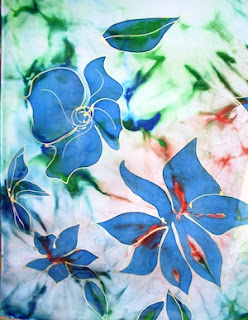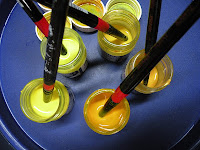I am guiding you here carefully to watching
the business part of your activities in the pursuit of your successful business venture.
With the knowledge and skill you gained so far
you are in the position to generate significant income.
I am encouraging you to direct your enthusiasm for learning additional method to the development of a revenue which will provide the financial background for your new learning.
You need to know where you stand financially.
Here are few numbers to consider at this little check-point of how you are doing now and how to set the financial control-mechanism.
So far you calculated your sales price with a "rule of thumb" by multiplying the materials by 2.5 or 3.
To look closer, a multiplication of 2.5-times of your material cost means that your material cost is 40% of the revenue/sales price (which represents 100%). A multiplication of 3-times the material cost means material is 33% of the sales price. For better understanding: The smaller the material cost-%-number, the better.
This might look good for the first look.
Now let's add little more detail to it with a bit of math in few very basic guidelines.
For starters, take a period of time, say your last month, and add up your expenses and then summon up also your total revenue for that period.
Define your profit - basic formula:
Revenue minus expenses equals your profit. (Revenue - Expenses = Profit)
With this formula you can
check how you are doing now.
As you'll grow your business
you will need more specific information and
bookkeeping is a must. There is a detailed chart of accounts in the bookkeeping systems to help you distinguish between the different types of expenses.
Examples of very simplified
cost categories for more informed picture
- material cost including shipping - cost of goods
- your time (evtl. and the pay for your helper) - proprietor's draw (and wages) cost of labour
- utilities, phone, rent for the portion of the space used for your business - location cost
- part of your vehicle expense for the business use - vehicle cost
- your website and advertising, fees for shows etc. office material expense - cost of advertising and office
- if you used loan for the start-up and pay interest and insurance on it - cost of borrowing
Note: The categories above do not reflect the bookkeeping
chart-system! This is to help you clarify your financial picture and to provide you with a tool for setting your financial goals for the future
.
Dollar figures are one way to read your financial business performance, I am using for
planning and evaluation percent numbers.
Basic formula in percent: Revenue (100%) - Cost in% of revenue = Profit in% of revenue
To define the %-number per cost-category, you will divide the total of that cost by the total of sales and multiply the result by 100.
In the example below the cost of goods was in total 40,000. To define the the corresponding %value I devided the total cost of good by total sales and multiplied the result by 100:
40,000 : 100,000 x 100 = 40%
This is an example for the cost in %-share of your revenue.
- cost of goods/material including shipping cost 40%
- wages your personal remuneration/draw (and helper's pay) 30%
- location cost 10%
- vehicle cost 5%
- cost of borrowing 5%
- profit 10%
- Note: if you add-up those %-numbers you will also get 100%
The percent numbers per category as listed above are just a guideline and will vary from business to business, but you can plan with this formula (using your own data):
Find answer to the Big Question: How much do you need to sell to make a living?
in dollar figures from the example above:
- sales of 100,000.00
- will give you 30.000 for personal income (proprietor's draw) and wages
- with 40,000 for materials
- 10,000 for rent and other location cost
- 5,000 for your vehicle use
- 5,000 for payment of your loan
- 10.000 profit / for your business expansion and reserve for opportunities
In this example, a revenue of 100,000 will give you 2,500 monthly income if you are working without a helper.
Note: It is natural to have higher cost at the start-up point when you need to buy all the basic equipment and set up the working station. The tendency but must lead up to more revenue and more profit.
Be enthusiastic about recording and know your numbers. Make a chart with
monthly comparison and use your amazing creativity to manage the numbers
to your favor.
The financial records are a tool to adjust for better results. You can lower the material cost, expand the revenue through additional service and much more.
Cost of material and labor will always be the largest portion and
in manufacturing your material cost should be lower then the cost of labor.
Apply your
creativity to generate better financial results, think teaching workshops and printed products etc.
If you are not "a number-person":) hire a bookkeeper or find other help.
You need to know your numbers in order to navigate your enterprise to the envisioned financial success.
Have fun with it!!


















































